Introduction to types of Neurons
Neurons are incredibly diverse in terms of size, shape, and function. The shape of a neuron plays a crucial role in determining its function and connectivity with other neurons. Neurons with widely branching dendrites can integrate a vast amount of information, while neurons with short dendritic branches pool information from fewer sources. These structural differences are directly tied to the specific roles neurons play within the nervous system.
What’s a Neuron?
- Neurons are the information-conducting units of the nervous system. (Kolb B. & Whishaw I., 2008)
- National Institute of Cancer (NIH) defines neuron as, “A type of cell that receives and sends messages from the body to the brain and back to the body. The messages are sent by a weak electrical current. Also called nerve cell.”
Read more about Anatomy of Neuron
Types of Neuron based on Functionality
1. Sensory Neurons
- Sensory neurons are responsible for transmitting sensory information from the body to the brain. They are designed for the direct transmission of information from sensory receptors to the brain, with minimal processing required in between. They allow us to perceive the environment, such as feeling touch, hearing sounds, or seeing light. They are structurally the simplest of all neurons.
- For example, bipolar neurons in the retina have a single short dendrite and axon. It allows them to efficiently transmit afferent sensory information to the brain’s visual centres.

Sensory Neuron
2. Interneurons
- Interneurons, also called association cells, connect sensory neurons to motor neurons and play a crucial role in information processing within the brain and spinal cord. These neurons branch extensively, enabling them to gather and integrate information from multiple sources. The number and complexity of interneurons are correlated with brain size and behavioral complexity across species.
- For example, pyramidal cells have long axons and pyramid-shaped cell bodies with two sets of dendrites, allowing them to carry information from the cortex to other brain regions. Purkinje cells in the cerebellum have highly branched dendrites, which allow them to process a large amount of information before relaying it to the rest of the brain and spinal cord.
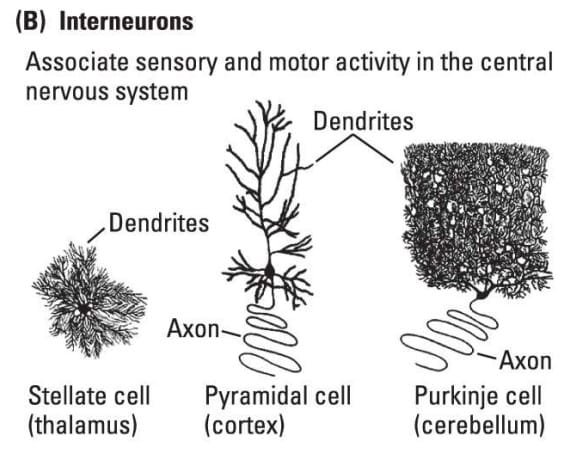
Interneurons
3. Motor Neurons
- Motor neurons are responsible for conveying information from the brain to muscles and glands, enabling movement and behavior. They typically have large cell bodies, extensive dendritic networks, and long axons that directly connect to muscle fibers. Motor neurons are located in the lower brainstem and spinal cord, and they are the final pathway through which efferent information reaches the muscles to initiate action.
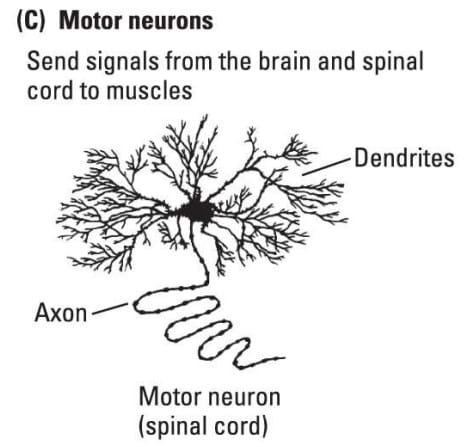
Motor Neuron
Types of neurons based on number of Projections (Processes)
Unipolar Neurons
Unipolar neurons are characterized by having a single process extending from their cell body. This process typically branches into two parts: one acts as a dendrite, and the other functions as an axon. Unipolar neurons are often found in sensory systems, where they transmit sensory information from the periphery to the central nervous system. Their unique structure allows them to quickly convey sensory signals with minimal processing.
Bipolar Neurons
Bipolar neurons have two distinct processes: one dendrite and one axon. These neurons are most commonly found in specialized sensory systems, such as in the retina of the eye and in the olfactory system. Their structure allows them to transmit sensory information directly to the brain, maintaining the polarity of input and output.
Multipolar Neurons
Multipolar neurons are the most common type of neuron. They have more than two processes extending from their cell body, including multiple dendrites and a single axon. These neurons are typically involved in integrating information from various sources and transmitting it to other neurons. Most motor neurons and interneurons in the brain are multipolar, playing crucial roles in complex neural circuits and motor control.
Multipolar Interneurons
Multipolar interneurons are a specific type of multipolar neuron that does not have an axon or has a very short axon. These neurons are primarily involved in the integration of neural activity within a single brain structure. Unlike motor neurons, which transmit signals to other areas, interneurons process and modulate signals locally within the same region of the nervous system. They play essential roles in reflexes, short-term memory, and controlling the activity of other neurons within a neural network.
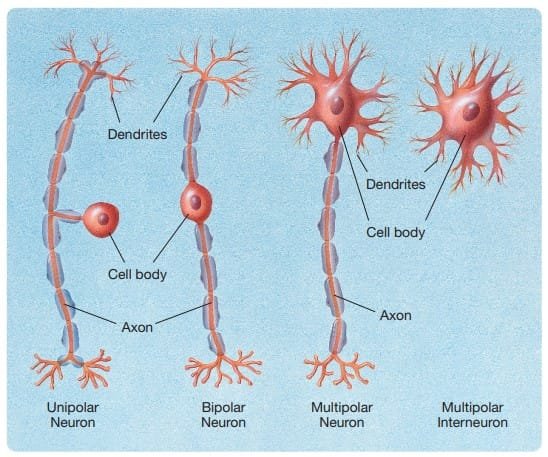
Based on Number of Processes in Neurons
Glial Cells: The Unsung Heroes of the Nervous System
Glial cells, derived from the Greek word meaning “glue,” serve as the crucial support network for neurons in the nervous system. While they do not transmit information in the same way neurons do, glial cells play a fundamental role in maintaining the health, function, and structure of neurons. They help neurons by providing support, nutrients, protection, and facilitating communication, among other functions. Unlike neurons, glial cells continue to be produced throughout an organism’s life, and errors in their replication can lead to abnormal growths, such as brain tumors.
Types of Glial Cells
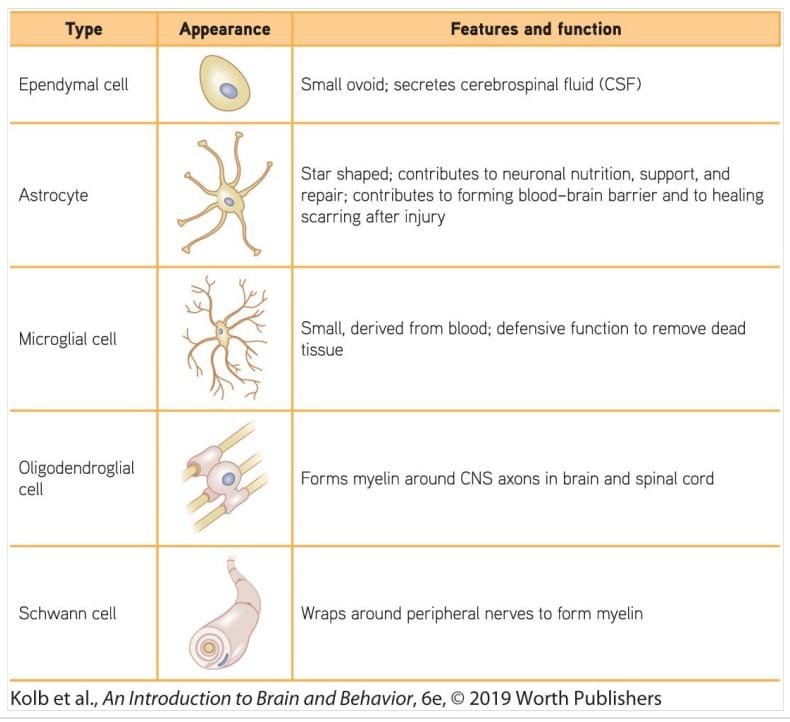
Types of Glial cells
1. Ependymal Cells:
- Ependymal cells line the ventricles in the brain. They are responsible for producing and secreting cerebrospinal fluid (CSF). CSF is vital for cushioning the brain, carrying away waste products, regulating brain temperature, and providing nutrients.
- Blockages in the flow of CSF can lead to conditions such as hydrocephalus, which can cause swelling of the head in infants and lead to severe cognitive impairments if untreated. Treatment may involve the insertion of a shunt to redirect the fluid (Nadkarni & Jung, 2003).
2. Astrocytes (Astroglia):
- Astrocytes are star-shaped glial cells that provide structural support to the central nervous system (CNS).They attach to blood vessels and form a scaffolding that holds neurons in place. Astrocytes also contribute to the formation of the blood-brain barrier, a protective partition that prevents harmful substances from entering the brain. However, this barrier also complicates the delivery of certain drugs, making brain infections difficult to treat.
- Additionally, astrocytes enhance brain activity by signalling blood vessels to increase blood flow and deliver more oxygen and glucose during neuronal activity (Kenny et al., 2018).
- After brain injury, astrocytes help by forming scar tissue to seal off damaged areas, although this can also hinder the regrowth of neurons
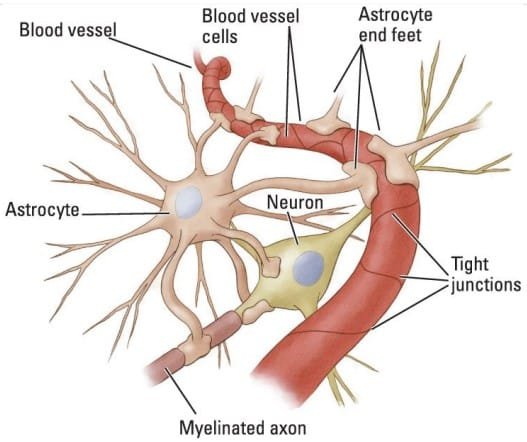
Blood–Brain Barrier : Astrocyte processes attach to neurons and to
blood vessel cells to stimulate them to form tight junctions and so form the blood–brain barrier
3. Microglia:
- Microglia are the immune cells of the CNS. Originating in the blood, they migrate throughout the brain and spinal cord, where they perform essential functions such as monitoring brain health, removing waste, and defending against foreign invaders.
- They engage in a process called phagocytosis, in which they engulf and digest dead neurons and foreign materials.
- Microglia are especially active in conditions like Alzheimer’s disease, where they may either help by clearing plaques or contribute to inflammation.
- Despite their small size, microglia play a critical role in maintaining the health of the nervous system (Lannes et al., 2017).
4. Oligodendrocytes and Schwann Cells:
- Oligodendrocytes and Schwann cells are responsible for the myelination of axons. Myelin acts as an insulating layer around axons, which speeds up the transmission of electrical signals between neurons (Somjen, 1988)
- Oligodendrocytes myelinate axons in the CNS, while Schwann cells perform this function in the peripheral nervous system (PNS).
- Schwann cells also play a role in neuron nutrition by absorbing and releasing chemicals, ensuring the proper functioning of neurons.
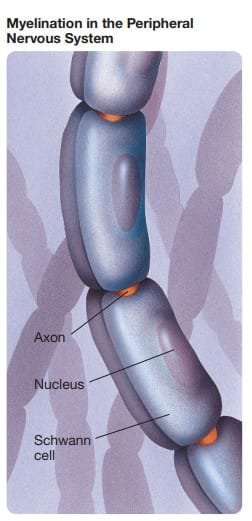
Myelination in the Peripheral Nervous System
Relation between neurons and glial cells
The relationship between glial cells and neurons is vital for brain function and plays a key role in nervous system diseases and recovery after injury. Damage to glial cells, especially oligodendroglia and Schwann cells, can be as debilitating as neuronal damage, as seen in multiple sclerosis (MS). These cells also aid in nervous system repair, particularly in the peripheral nervous system (PNS), but their role in the central nervous system (CNS) repair is more limited.
Glial Cells and Disease
Multiple sclerosis (MS) is an autoimmune disorder where the immune system attacks oligodendroglia in the CNS, leading to scar tissue formation instead of myelin. This disrupts nerve signal transmission, impairing movement and cognition. MS highlights the crucial role of glial cells in maintaining neuronal pathways (Hirokawa et al., 2017).
Glial Cells in Repair and Regeneration
In the PNS, when an axon is severed, Schwann cells and microglia assist in the repair process. Schwann cells clear debris and form a path for regrowing axons, ultimately restoring function. This regenerative capacity contrasts with the CNS, where repair is limited. Oligodendrocytes in the CNS do not promote regeneration; instead, they may inhibit it to maintain neural structure (Hirokawa et al., 2017).
Conclusion
In conclusion, neurons and glial cells are essential components of the nervous system, each serving distinct yet complementary roles. Neurons, classified based on their structure—unipolar, bipolar, and multipolar—are responsible for transmitting signals and processing information. Unipolar and bipolar neurons typically handle sensory input, while multipolar neurons, including interneurons, are involved in complex processing and integration within the nervous system.
Glial cells, on the other hand, provide crucial support, nourishment, and protection to neurons. From astrocytes that maintain the blood-brain barrier and support neural activity, to microglia that act as immune cells, and oligodendroglia and Schwann cells that insulate axons, glial cells are fundamental in maintaining the health and functionality of the nervous system. Together, neurons and glial cells ensure the proper functioning of the brain and nervous system, facilitating communication, repair, and overall homeostasis.
Check Your Understanding on Types of Neurons and Glial cells
Read more about Neuropsychology
References
- Brain Basics: the life and death of a neuron. National Institute of Neurological Disorders and Stroke. https://www.ninds.nih.gov/health-information/public-education/brain-basics/brain-basics-life-and-death-neuron
- Kalat, J. W. (2019). Biological psychology. Cengage.
- Kolb, B., & Whishaw, I. Q. (2019). An introduction to brain and behavior.
- Pinel, J. (2018). Biopsychology 10th Edition. Pearson.
Niwlikar, B. A. (2025, January 18). Types of Neurons and Glial Cells. Careershodh. https://www.careershodh.com/types-of-neurons-and-glial-cells/
